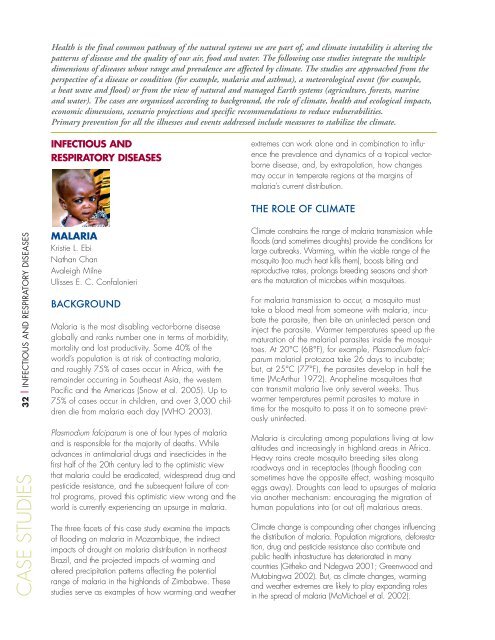Climate change futures: health, ecological and economic dimensions
Climate change futures: health, ecological and economic dimensions
Climate change futures: health, ecological and economic dimensions
Create successful ePaper yourself
Turn your PDF publications into a flip-book with our unique Google optimized e-Paper software.
Health is the final common pathway of the natural systems we are part of, <strong>and</strong> climate instability is altering the<br />
patterns of disease <strong>and</strong> the quality of our air, food <strong>and</strong> water. The following case studies integrate the multiple<br />
<strong>dimensions</strong> of diseases whose range <strong>and</strong> prevalence are affected by climate. The studies are approached from the<br />
perspective of a disease or condition (for example, malaria <strong>and</strong> asthma), a meteorological event (for example,<br />
a heat wave <strong>and</strong> flood) or from the view of natural <strong>and</strong> managed Earth systems (agriculture, forests, marine<br />
<strong>and</strong> water). The cases are organized according to background, the role of climate, <strong>health</strong> <strong>and</strong> <strong>ecological</strong> impacts,<br />
<strong>economic</strong> <strong>dimensions</strong>, scenario projections <strong>and</strong> specific recommendations to reduce vulnerabilities.<br />
Primary prevention for all the illnesses <strong>and</strong> events addressed include measures to stabilize the climate.<br />
INFECTIOUS AND<br />
RESPIRATORY DISEASES<br />
extremes can work alone <strong>and</strong> in combination to influence<br />
the prevalence <strong>and</strong> dynamics of a tropical vectorborne<br />
disease, <strong>and</strong>, by extrapolation, how <strong>change</strong>s<br />
may occur in temperate regions at the margins of<br />
malaria’s current distribution.<br />
THE ROLE OF CLIMATE<br />
32 | INFECTIOUS AND RESPIRATORY DISEASES<br />
CASE STUDIES<br />
MALARIA<br />
Kristie L. Ebi<br />
Nathan Chan<br />
Avaleigh Milne<br />
Ulisses E. C. Confalonieri<br />
BACKGROUND<br />
Malaria is the most disabling vector-borne disease<br />
globally <strong>and</strong> ranks number one in terms of morbidity,<br />
mortality <strong>and</strong> lost productivity. Some 40% of the<br />
world’s population is at risk of contracting malaria,<br />
<strong>and</strong> roughly 75% of cases occur in Africa, with the<br />
remainder occurring in Southeast Asia, the western<br />
Pacific <strong>and</strong> the Americas (Snow et al. 2005). Up to<br />
75% of cases occur in children, <strong>and</strong> over 3,000 children<br />
die from malaria each day (WHO 2003).<br />
Plasmodium falciparum is one of four types of malaria<br />
<strong>and</strong> is responsible for the majority of deaths. While<br />
advances in antimalarial drugs <strong>and</strong> insecticides in the<br />
first half of the 20th century led to the optimistic view<br />
that malaria could be eradicated, widespread drug <strong>and</strong><br />
pesticide resistance, <strong>and</strong> the subsequent failure of control<br />
programs, proved this optimistic view wrong <strong>and</strong> the<br />
world is currently experiencing an upsurge in malaria.<br />
The three facets of this case study examine the impacts<br />
of flooding on malaria in Mozambique, the indirect<br />
impacts of drought on malaria distribution in northeast<br />
Brazil, <strong>and</strong> the projected impacts of warming <strong>and</strong><br />
altered precipitation patterns affecting the potential<br />
range of malaria in the highl<strong>and</strong>s of Zimbabwe. These<br />
studies serve as examples of how warming <strong>and</strong> weather<br />
<strong>Climate</strong> constrains the range of malaria transmission while<br />
floods (<strong>and</strong> sometimes droughts) provide the conditions for<br />
large outbreaks. Warming, within the viable range of the<br />
mosquito (too much heat kills them), boosts biting <strong>and</strong><br />
reproductive rates, prolongs breeding seasons <strong>and</strong> shortens<br />
the maturation of microbes within mosquitoes.<br />
For malaria transmission to occur, a mosquito must<br />
take a blood meal from someone with malaria, incubate<br />
the parasite, then bite an uninfected person <strong>and</strong><br />
inject the parasite. Warmer temperatures speed up the<br />
maturation of the malarial parasites inside the mosquitoes.<br />
At 20°C (68°F), for example, Plasmodium falciparum<br />
malarial protozoa take 26 days to incubate;<br />
but, at 25°C (77°F), the parasites develop in half the<br />
time (McArthur 1972). Anopheline mosquitoes that<br />
can transmit malaria live only several weeks. Thus<br />
warmer temperatures permit parasites to mature in<br />
time for the mosquito to pass it on to someone previously<br />
uninfected.<br />
Malaria is circulating among populations living at low<br />
altitudes <strong>and</strong> increasingly in highl<strong>and</strong> areas in Africa.<br />
Heavy rains create mosquito breeding sites along<br />
roadways <strong>and</strong> in receptacles (though flooding can<br />
sometimes have the opposite effect, washing mosquito<br />
eggs away). Droughts can lead to upsurges of malaria<br />
via another mechanism: encouraging the migration of<br />
human populations into (or out of) malarious areas.<br />
<strong>Climate</strong> <strong>change</strong> is compounding other <strong>change</strong>s influencing<br />
the distribution of malaria. Population migrations, deforestation,<br />
drug <strong>and</strong> pesticide resistance also contribute <strong>and</strong><br />
public <strong>health</strong> infrastructure has deteriorated in many<br />
countries (Githeko <strong>and</strong> Ndegwa 2001; Greenwood <strong>and</strong><br />
Mutabingwa 2002). But, as climate <strong>change</strong>s, warming<br />
<strong>and</strong> weather extremes are likely to play exp<strong>and</strong>ing roles<br />
in the spread of malaria (McMichael et al. 2002).

















